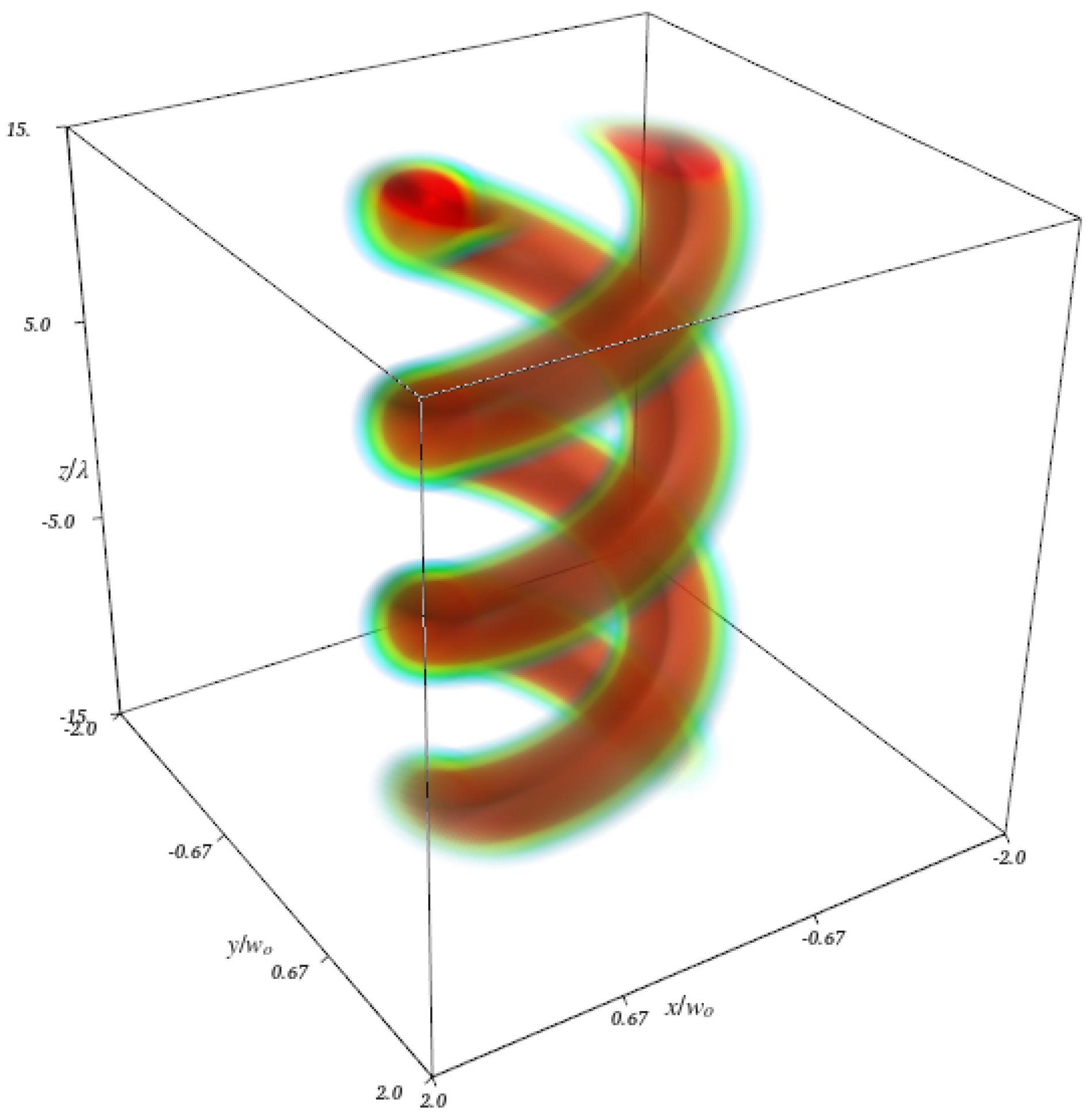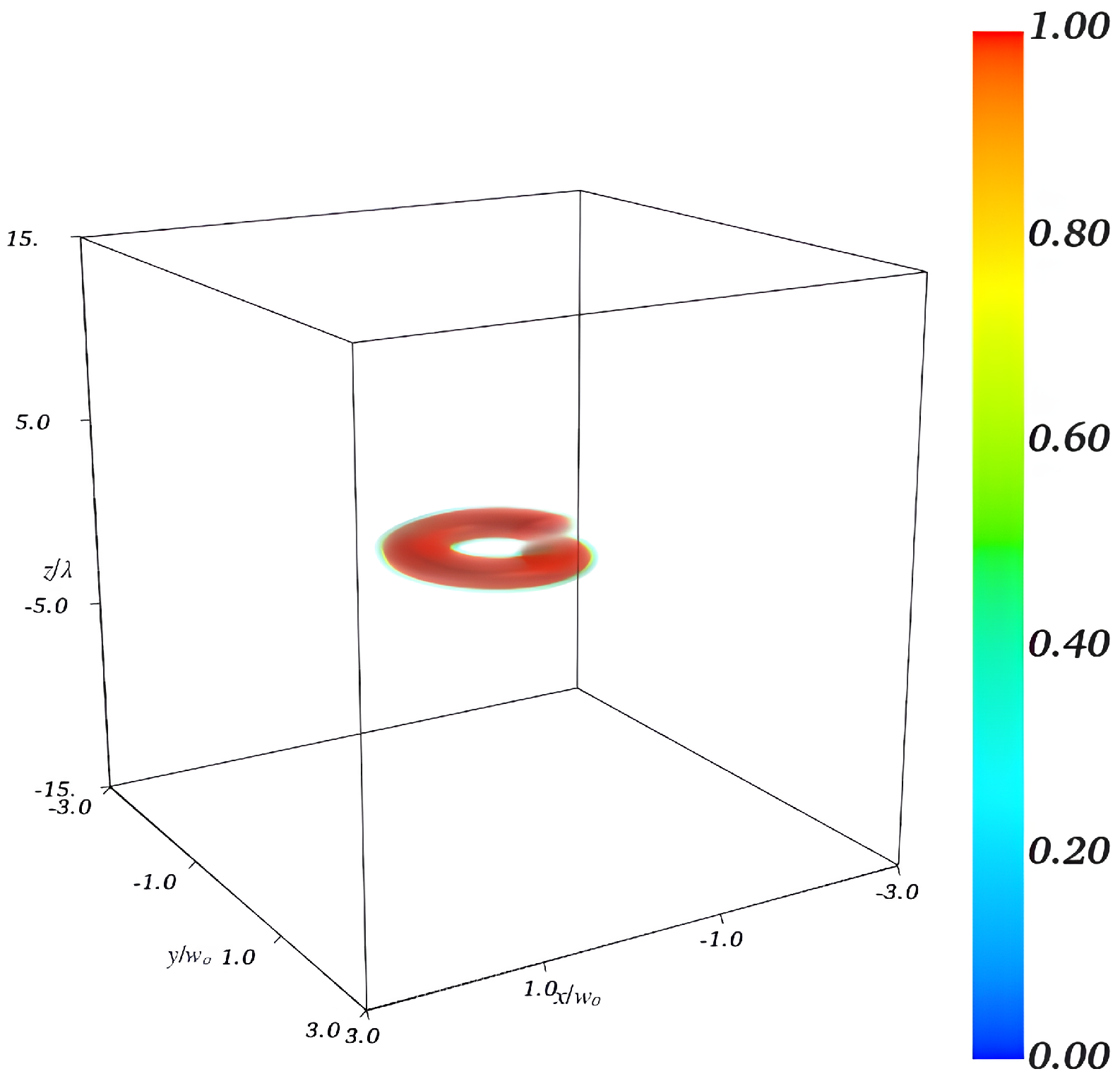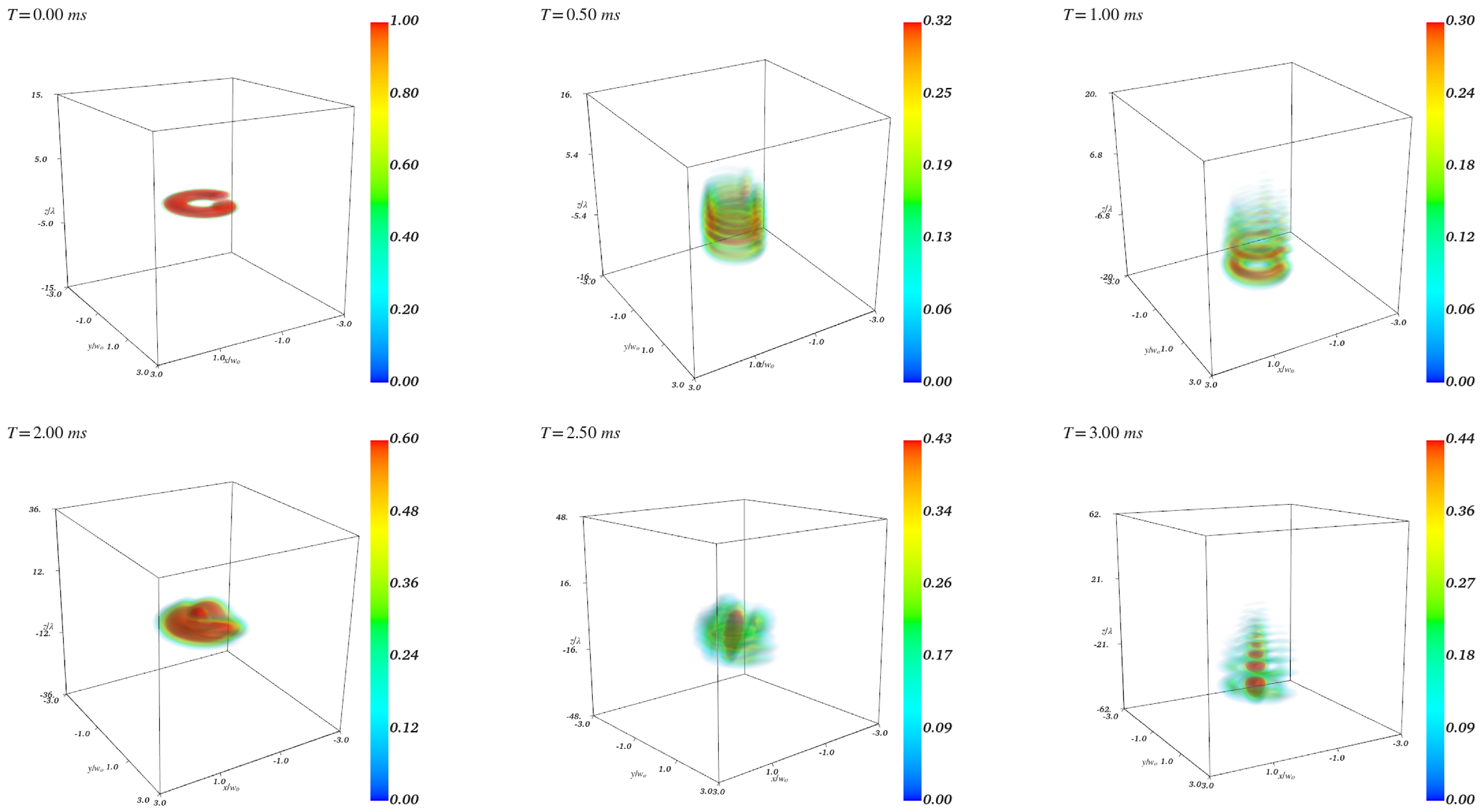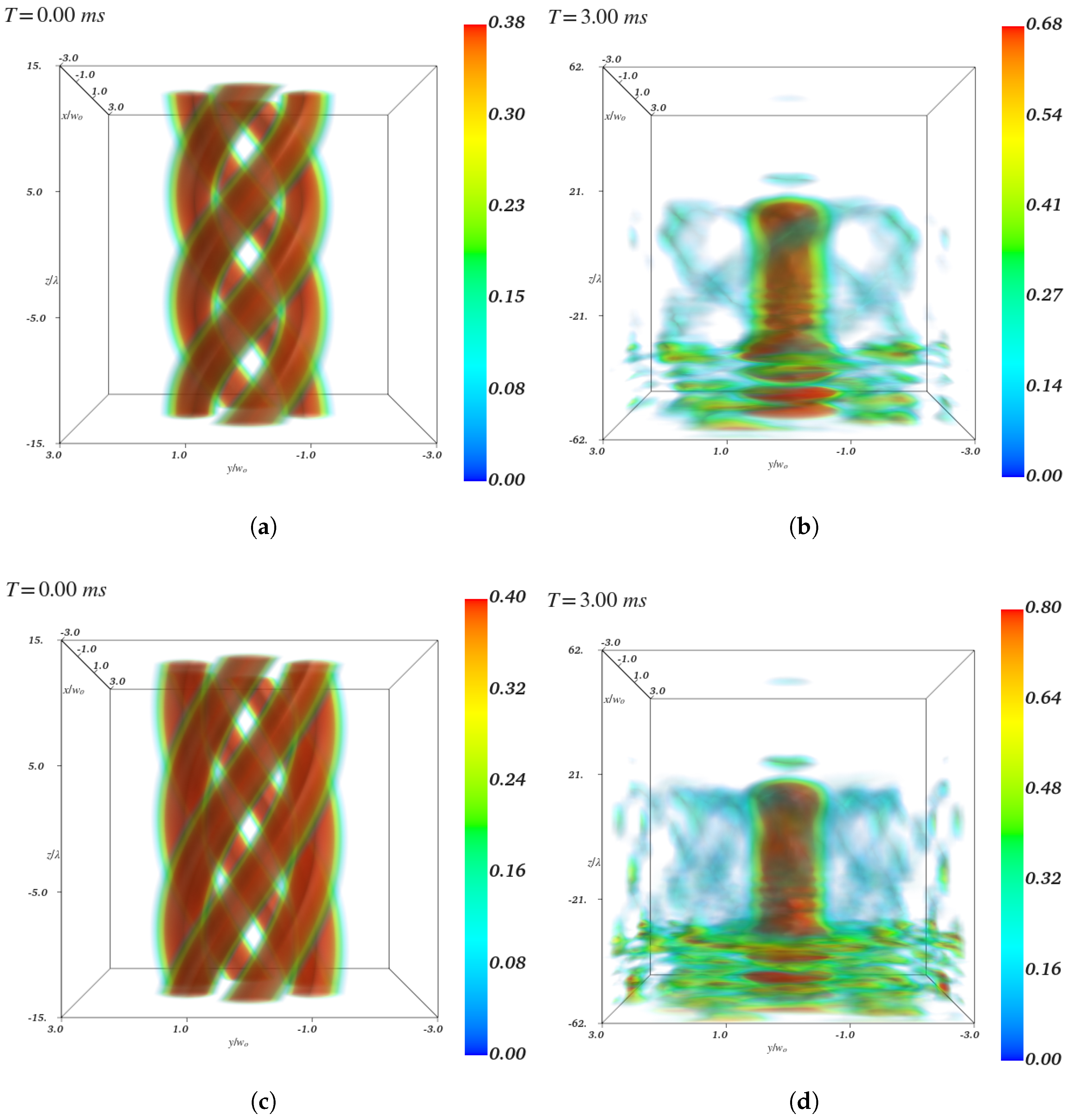Towards a Twisted Atom Laser: Cold Atoms Released from Helical Optical Tube Potentials
Abstract
1. Introduction
2. Materials and Methods
2.1. Optical Potential in Helical Coordinates
2.2. Stationary Schrödinger Equation and Ground State
2.2.1. Two-Level Atom
2.2.2. Bose–Einstein Condensate
3. Free Fall Under Gravity
4. Results and Discussion
4.1. Two-Level Atom
4.1.1. Influence of the Beam Waist
4.1.2. Dynamics for Longer Time
4.2. BEC Dynamics in Free Fall
4.2.1.
4.2.2.
- -
- For : The BEC expands and forms a vertically stretched, column-like structure, with concentric rings and interference fringes appearing toward the lower region. The wavefunction remains relatively coherent, although interactions generate radial modulations indicative of nonlinear phase evolution.
- -
- For : A pronounced central peak develops during free fall, with a sharper and more confined density maximum at the center of mass. This suggests a stronger self-focusing effect, likely driven by the more intricate initial twist structure and associated higher spatial confinement. The condensate appears to resist radial dispersion more effectively than in the case, with maximum probability density regions (presented in red color) close to 0.80. Simultaneously, strong interference fringes appear, especially in the lower region, indicating intensified nonlinear wave mixing during expansion.
5. Conclusions
Author Contributions
Funding
Institutional Review Board Statement
Data Availability Statement
Conflicts of Interest
Abbreviations
| HOT | Hot Optical Tube |
| LG | Laguerre–Gauss |
| BEC | Bose–Einstein Condensate |
| TDSE | Time-Dependent Schrödinger Equation |
| GPE | Gross–Pitaevskii Equation |
References
- Cohen-Tannoudji, C.; Guéry-Odelin, D. Advances in Atomic Physics: An Overview; World Scientific Pub Co Inc.: Hackensack, NJ, USA, 2011. [Google Scholar]
- Meystre, P. Atom Optics; Springer Science & Business Media: Berlin/Heidelberg, Germany, 2001; Volume 33. [Google Scholar]
- Hess, H.F. Evaporative cooling of magnetically trapped and compressed spin-polarized hydrogen. Phys. Rev. B 1986, 34, 3476. [Google Scholar] [CrossRef] [PubMed]
- Anderson, M.H.; Ensher, J.R.; Matthews, M.R.; Wieman, C.E.; Cornell, E.A. Observation of Bose-Einstein condensation in a dilute atomic vapor. Science 1995, 269, 198–201. [Google Scholar] [CrossRef] [PubMed]
- Davis, K.B.; Mewes, M.O.; Andrews, M.R.; van Druten, N.J.; Durfee, D.S.; Kurn, D.; Ketterle, W. Bose-Einstein condensation in a gas of sodium atoms. Phys. Rev. Lett. 1995, 75, 3969. [Google Scholar] [CrossRef] [PubMed]
- Colombe, Y.; Steinmetz, T.; Dubois, G.; Linke, F.; Hunger, D.; Reichel, J. Strong atom–field coupling for Bose–Einstein condensates in an optical cavity on a chip. Nature 2007, 450, 272–276. [Google Scholar] [CrossRef]
- Robins, N.; Altin, P.; Debs, J.; Close, J. Atom lasers: Production, properties and prospects for precision inertial measurement. Phys. Rep. 2013, 529, 265–296. [Google Scholar] [CrossRef]
- Boto, A.N.; Kok, P.; Abrams, D.S.; Braunstein, S.L.; Williams, C.P.; Dowling, J.P. Quantum interferometric optical lithography: Exploiting entanglement to beat the diffraction limit. Phys. Rev. Lett. 2000, 85, 2733. [Google Scholar] [CrossRef]
- Fujita, J.; Mitake, S.; Shimizu, F. Interferometric modulation of an atomic beam by an electric field: A phase hologram for atoms. Phys. Rev. Lett. 2000, 84, 4027. [Google Scholar] [CrossRef]
- Becker, D.; Lachmann, M.D.; Seidel, S.T.; Ahlers, H.; Dinkelaker, A.N.; Grosse, J.; Hellmig, O.; Müntinga, H.; Schkolnik, V.; Wendrich, T.; et al. Space-borne Bose–Einstein condensation for precision interferometry. Nature 2018, 562, 391–395. [Google Scholar] [CrossRef]
- Lenz, G.; Meystre, P.; Wright, E.M. Nonlinear atom optics. Phys. Rev. Lett. 1993, 71, 3271. [Google Scholar] [CrossRef]
- Salieres, P.; L’huillier, A.; Antoine, P.; Lewenstein, M. Study of the spatial and temporal coherence of high-order harmonics. In Advances in Atomic, Molecular, and Optical Physics; Elsevier: Amsterdam, The Netherlands, 1999; Volume 41, pp. 83–142. [Google Scholar]
- Khaykovich, L.; Schreck, F.; Ferrari, G.; Bourdel, T.; Cubizolles, J.; Carr, L.D.; Castin, Y.; Salomon, C. Formation of a matter-wave bright soliton. Science 2002, 296, 1290–1293. [Google Scholar] [CrossRef]
- Yan, L.; Lannig, S.; Milner, W.R.; Frankel, M.N.; Lewis, B.; Lee, D.; Kim, K.; Ye, J. High-Power Clock Laser Spectrally Tailored for High-Fidelity Quantum State Engineering. Phys. Rev. X 2025, 15, 031055. [Google Scholar] [CrossRef]
- Beydler, M.M.; Moan, E.R.; Luo, Z.; Chu, Z.; Sackett, C.A. Guided-wave Sagnac atom interferometer with large area and multiple orbits. AVS Quantum Sci. 2024, 6, 014401. [Google Scholar] [CrossRef]
- Huang, T.; Yu, Z.; Ni, Z.; Zhou, X.; Li, X. Quantum force sensing by digital twinning of atomic Bose–Einstein condensates. Commun. Phys. 2024, 7, 172. [Google Scholar] [CrossRef]
- Okulov, A. Superfluid rotation sensor with helical laser trap. J. Low Temp. Phys. 2013, 171, 397–407. [Google Scholar] [CrossRef]
- Meng, Y.; Gao, Z.; Zhu, X.; Yang, Y.; Shi, Y.; Deng, Z.; Cao, Y.; Zhang, Y.; Zhan, W.; Zhang, X.; et al. Observation of Bose–Einstein condensation in a moiré superlattice. Nature 2023, 615, 231–236. [Google Scholar] [CrossRef]
- Allen, L.; Beijersbergen, M.W.; Spreeuw, R.; Woerdman, J. Orbital angular momentum of light and the transformation of Laguerre-Gaussian laser modes. Phys. Rev. A 1992, 45, 8185. [Google Scholar] [CrossRef] [PubMed]
- Allen, L.; Padgett, M.; Babiker, M. IV The orbital angular momentum of light. Prog. Opt. 1999, 39, 291–372. [Google Scholar]
- Babiker, M.; Andrews, D.L.; Lembessis, V.E. Atoms in complex twisted light. J. Opt. 2018, 21, 013001. [Google Scholar] [CrossRef]
- Franke-Arnold, S.; Leach, J.; Padgett, M.J.; Lembessis, V.E.; Ellinas, D.; Wright, A.J.; Girkin, J.M.; Öhberg, P.; Arnold, A.S. Optical ferris wheel for ultracold atoms. Opt. Express 2007, 15, 8619–8625. [Google Scholar] [CrossRef]
- Lembessis, V.; Lyras, A.; Aldossary, O. Optical Ferris wheels as a platform for collisional quantum gates. J. Opt. Soc. Am. B 2020, 38, 233–240. [Google Scholar] [CrossRef]
- Lembessis, V.E. Atomic Ferris wheel beams. Phys. Rev. A 2017, 96, 013622. [Google Scholar] [CrossRef]
- Okulov, V.L.; Sørensen, J.N. The self-induced motion of a helical vortex. J. Fluid Mech. 2020, 883, A5. [Google Scholar] [CrossRef]
- Lembessis, V.; Lyras, A.; Aldossary, O. Quantum states of a two-level atom trapped in a helical optical tube. J. Opt. Soc. Am. B 2022, 39, 2319–2328. [Google Scholar] [CrossRef]
- Al Rsheed, A.; Lyras, A.; Lembessis, V.E.; Aldossary, O.M. Guiding of atoms in helical optical potential structures. J. Phys. At. Mol. Opt. Phys. 2016, 49, 125002. [Google Scholar] [CrossRef]
- Kosloff, R.; Tal-Ezer, H. A direct relaxation method for calculating eigenfunctions and eigenvalues of the Schrödinger equation on a grid. Chem. Phys. Lett. 1986, 127, 223–230. [Google Scholar] [CrossRef]
- Ramachandran, P.; Varoquaux, G. Mayavi: 3D Visualization of Scientific Data. Comput. Sci. Eng. 2011, 13, 40–51. [Google Scholar] [CrossRef]
- Grimm, R.; Weidemüller, M.; Ovchinnikov, Y.B. Optical Dipole Traps for Neutral Atoms. Adv. At. Mol. Opt. Phys. 2000, 42, 95–170. [Google Scholar] [CrossRef]
- Morsch, O.; Oberthaler, M. Dynamics of Bose–Einstein condensates in optical lattices. Rev. Mod. Phys. 2006, 78, 179–215. [Google Scholar] [CrossRef]
- Metcalf, H.J.; van der Straten, P. Laser Cooling and Trapping; Graduate Texts in Contemporary Physics; Springer: New York, NY, USA, 1999; p. 25. [Google Scholar] [CrossRef]
- Gaaloul, N.; Jaouadi, A.; Pruvost, L.; Viaris de Lesegno, B.; Telmini, M.; Pruvost, L. Controlled deflection of cold atomic clouds and of Bose-Einstein condensates. Eur. Phys. J. D 2009, 53, 343–351. [Google Scholar] [CrossRef]
- Steck, D.A. Rubidium 87 D Line Data. 2001. Available online: http://steck.us/alkalidata (accessed on 12 August 2025).
- Miller, J.D.; Cline, R.A.; Heinzen, D.J. Far-off-resonance optical trapping of atoms. Phys. Rev. A 1993, 47, R4567–R4570. [Google Scholar] [CrossRef]
- Barrett, M.D.; Sauer, J.A.; Chapman, M.S. All-Optical Formation of an Atomic Bose-Einstein Condensate. Phys. Rev. Lett. 2001, 87, 010404. [Google Scholar] [CrossRef] [PubMed]
- Beterov, I.I.; Yakshina, E.A.; Tretyakov, D.B.; Entin, V.M.; Singh, U.; Kudlaev, Y.V.; Yu Mityanin, K.; Panov, K.A.; Alyanova, N.V.; Andreeva, C.; et al. Trapping, detection and manipulation of single Rb atoms in an optical dipole trap using a long-focus objective lens. J. Physics: Conf. Ser. 2021, 1859, 012049. [Google Scholar] [CrossRef]
- Moan, E.R.; Horne, R.A.; Arpornthip, T.; Luo, Z.; Fallon, A.J.; Berl, S.J.; Sackett, C.A. Quantum Rotation Sensing with Dual Sagnac Interferometers in an Atom-Optical Waveguide. Phys. Rev. Lett. 2020, 124, 120403. [Google Scholar] [CrossRef]
- Schubert, C.; Abend, S.; Gersemann, M.; Gebbe, M.; Schlippert, D.; Berg, P.; Rasel, E.M. Multi-loop atomic Sagnac interferometry. Sci. Rep. 2021, 11, 16121. [Google Scholar] [CrossRef]
- Célanie, E.; Delisle, L.; Jaouadi, A. Optically tuned soliton dynamics in Bose-Einstein condensates within dark traps. J. Phys. Math. Theor. 2024, 57, 485701. [Google Scholar] [CrossRef]
- Delisle, L.; Jaouadi, A. Symmetry-Driven Multi-Soliton Dynamics in Bose–Einstein Condensates in Reduced Dimensions. Symmetry 2025, 17, 582. [Google Scholar] [CrossRef]






Disclaimer/Publisher’s Note: The statements, opinions and data contained in all publications are solely those of the individual author(s) and contributor(s) and not of MDPI and/or the editor(s). MDPI and/or the editor(s) disclaim responsibility for any injury to people or property resulting from any ideas, methods, instructions or products referred to in the content. |
© 2025 by the authors. Licensee MDPI, Basel, Switzerland. This article is an open access article distributed under the terms and conditions of the Creative Commons Attribution (CC BY) license (https://creativecommons.org/licenses/by/4.0/).
Share and Cite
Jaouadi, A.; Lyras, A.; Lembessis, V.E. Towards a Twisted Atom Laser: Cold Atoms Released from Helical Optical Tube Potentials. Photonics 2025, 12, 999. https://doi.org/10.3390/photonics12100999
Jaouadi A, Lyras A, Lembessis VE. Towards a Twisted Atom Laser: Cold Atoms Released from Helical Optical Tube Potentials. Photonics. 2025; 12(10):999. https://doi.org/10.3390/photonics12100999
Chicago/Turabian StyleJaouadi, Amine, Andreas Lyras, and Vasileios E. Lembessis. 2025. "Towards a Twisted Atom Laser: Cold Atoms Released from Helical Optical Tube Potentials" Photonics 12, no. 10: 999. https://doi.org/10.3390/photonics12100999
APA StyleJaouadi, A., Lyras, A., & Lembessis, V. E. (2025). Towards a Twisted Atom Laser: Cold Atoms Released from Helical Optical Tube Potentials. Photonics, 12(10), 999. https://doi.org/10.3390/photonics12100999




